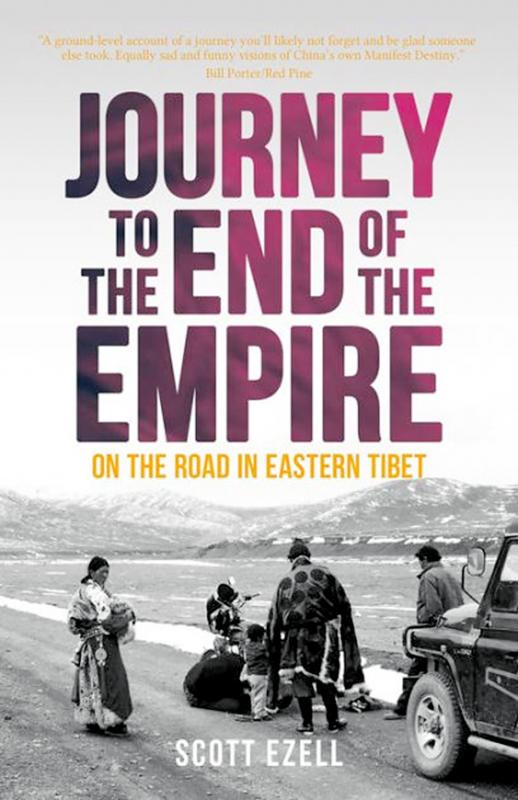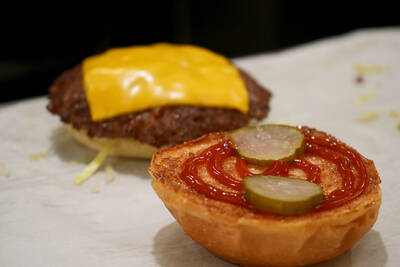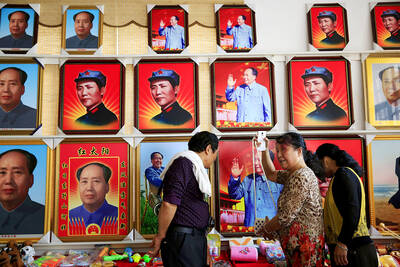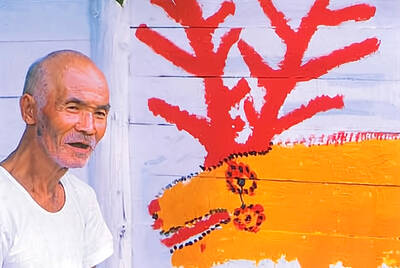There is absolutely no doubt that this is a really magnificent book.
Scott Ezell previously wrote A Far Corner, about life among wood-carvers in south-eastern Taiwan (reviewed in the Taipei Times April 16, 2015). I rated that an instant classic. Now he has come up with a book about a journey from China’s Yunnan Province, through Sichuan, to Qinghai Province. It begins in Dali and ends in Golmud. He travels by bus, motorbike and hitch-hiking.
A Far Corner was a book without villains, but this new product has modern China as its devil incarnate. It’s the “empire” of the title, though it’s not the only harm-doer. Ezell is undoubtedly aware of the past achievements of the Chinese, especially in science (as Joseph Needham showed in his multi-volume Science and Civilization in China), but modern China is, to Ezell, a destroyer of ecosystems.

Massive dam systems “killed rivers and displaced communities, mountains were raked apart ... and the region was increasingly militarized and surveiled as China tilted towards its grim police state superpower status.”
But the US is another such empire to Ezell. Was it normal in your country to travel so far, a Tibetan asks him.
“Normal? Cheering like a drunken football fan for the army of the country where you were born was normal. Being imprisoned or killed by your own government was normal. Dropping bombs was normal, selling bombs was normal, bombs blowing up children as if it were deplorable, regrettable, reprehensible, but unavoidable and acceptable was normal. Normal was burning the world and sucking the earth from beneath our feet. Normal was a hell-hound on my trail.”
Scott Ezell, an American, stands 198cm tall, he tells us. He has tried corporate work in Taipei, and has lived on an uninhabited islet in Hong Kong harbor. He’s a musician who, in Taiwan’s south-east, made analogue recordings that included the sound of the sea. He is a published poet, but above all he’s a conservationist.
When he discovers that a kind of river dolphin used to swim for 20 million years in the waters of the river he is contemplating until it was exterminated by starving farmers during Mao Zedong’s (毛澤東) Great Leap Forward, he writes: “Back in Dali, Liu had said ‘Sucks to be a pig’ (they had just watched one being slaughtered). Sucks to be a dolphin too, apparently. Sucks to be a non-human being during the Anthropocene, or a human one if you like living in a world with river dolphins, blue whales, elephants, rhinos, wild tigers, or with living forests, rivers, coral reefs, or breathable air.”
The route north he follows was in part walked by the Long March, but Ezell is not interested in that. Instead, he’s drawn to the amiable Tibetans and even the friendly Han Chinese who were relocated to the region by government fiat. The villains are the government agents constructing dams that will be “square and monochrome, monolithic, right angles and straight lines of utility and decree.”
But not everything’s ugly. This poet sees landscapes of exceptional magnificence and beauty, with a myriad flowers, and a donkey’s cry echoing across the mountainside “like all the broken dreams of men.”
He ends up on the highest and most extensive plateau on earth, half a mile higher than the highest mountain in the contiguous US, and there watches the construction of the railway from Golmud to Lhasa that Swiss engineers had said was an impossibility, but that the Chinese had built anyway. Ezell was first there in September 2004, but revisited the region 20 times before completing this book.
At his highest elevation, some 17,000 feet, he laments that he’s enthralled by such beauty, and such mighty animal migration, but fears he’ll never revisit the place in this lifetime.
Ezell is a philosopher too. “We can explain the complexities of the universe,” he writes, “but the fundamental simplicities are beyond us.”
The book isn’t without its sardonic wit either. Baijiu (白酒), the author says, is an adaptable liquid that if you don’t drink it can be used as lighter fuel or paint stripper. The black-and-white photos are idiosyncratic but certainly atmospheric.
At one point he is asked by someone cutting up a yak’s head if they have machines to do such work in the US. He replies that with Jello, Spam, corn flakes and a lot more, yes, they do have machines. This is another example of Ezell using a chance incident to expatiate on wider issues, in this case the degraded nature of much of the American diet.
Up at his highest point, Ezell helps feed orphan antelopes on a reservation. His heart goes out to them, though when a bus full of tourists arrives — all as cold as he is — he feels they can have little sense of the context, the vast distances their herds will have traveled, and will travel again. He’s given a lift down to Golmud by someone who is obliged to pick up some waste from a government site for disposal. No point in trying to refuse, the driver comments.
In Golmud he is strip-searched, or so it would seem — made to bend over a table with his wrists beaten if he tries to resist. Needless to say, this only goes to confirm his dark view of the authorities.
Love is mixed with sadness throughout this fine book, love for the locals he meets and sadness at the conditions they are being forced to endure. His flights of poetry, therefore, tend to be detached from the main drift of the narrative, and were possibly inserted after later visits.
Eastern Tibet isn’t part of Tibet proper, but seems nonetheless to have endured most of the depredations suffered by the central areas. A Buddhist perspective prevails, even so. When he asks a senior lama if the People’s Liberation Army stayed long after they had destroyed the original building, the lama replies it wasn’t long, just 20 years.
And as for the destruction of religious buildings in general, Ezell observes that they are now being re-built, but as gaudy tourist destinations that the original monks are loathe to inhabit.
The author was invariably cold, often hungry and beset by an increasing altitude sickness. He managed to pen a remarkable text nonetheless. It isn’t being published till May 24 but is available now for pre-order from Amazon.com. It’s hard to imagine anyone being disappointed by it.

Taiwan can often feel woefully behind on global trends, from fashion to food, and influences can sometimes feel like the last on the metaphorical bandwagon. In the West, suddenly every burger is being smashed and honey has become “hot” and we’re all drinking orange wine. But it took a good while for a smash burger in Taipei to come across my radar. For the uninitiated, a smash burger is, well, a normal burger patty but smashed flat. Originally, I didn’t understand. Surely the best part of a burger is the thick patty with all the juiciness of the beef, the

The ultimate goal of the Chinese Communist Party (CCP) is the total and overwhelming domination of everything within the sphere of what it considers China and deems as theirs. All decision-making by the CCP must be understood through that lens. Any decision made is to entrench — or ideally expand that power. They are fiercely hostile to anything that weakens or compromises their control of “China.” By design, they will stop at nothing to ensure that there is no distinction between the CCP and the Chinese nation, people, culture, civilization, religion, economy, property, military or government — they are all subsidiary

Nov.10 to Nov.16 As he moved a large stone that had fallen from a truck near his field, 65-year-old Lin Yuan (林淵) felt a sudden urge. He fetched his tools and began to carve. The recently retired farmer had been feeling restless after a lifetime of hard labor in Yuchi Township (魚池), Nantou County. His first piece, Stone Fairy Maiden (石仙姑), completed in 1977, was reportedly a representation of his late wife. This version of how Lin began his late-life art career is recorded in Nantou County historian Teng Hsiang-yang’s (鄧相揚) 2009 biography of him. His expressive work eventually caught the attention

This year’s Miss Universe in Thailand has been marred by ugly drama, with allegations of an insult to a beauty queen’s intellect, a walkout by pageant contestants and a tearful tantrum by the host. More than 120 women from across the world have gathered in Thailand, vying to be crowned Miss Universe in a contest considered one of the “big four” of global beauty pageants. But the runup has been dominated by the off-stage antics of the coiffed contestants and their Thai hosts, escalating into a feminist firestorm drawing the attention of Mexico’s president. On Tuesday, Mexican delegate Fatima Bosch staged a